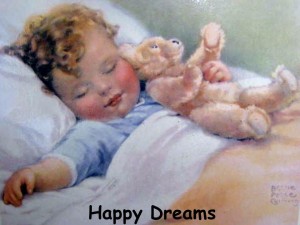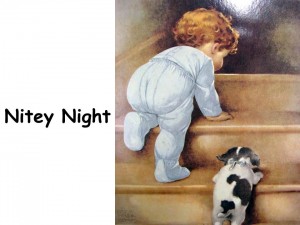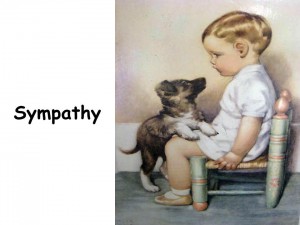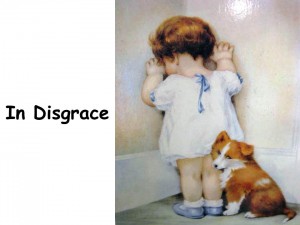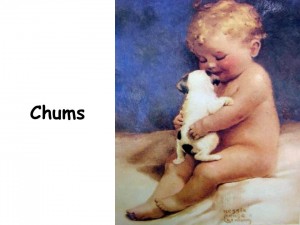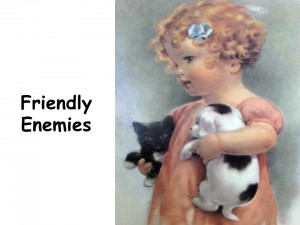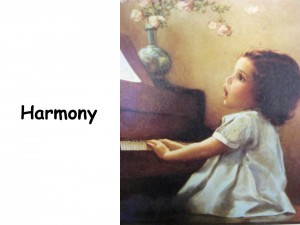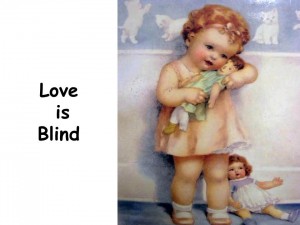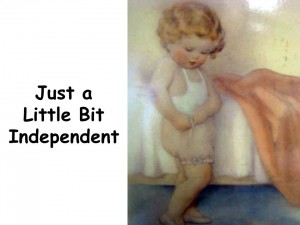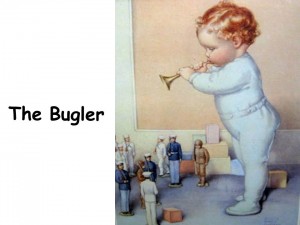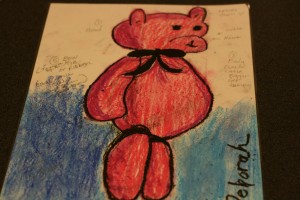1. Awakening
2.
3.
4.
5.
6.
7.
8.
9.
10.
11.
12.
Sample Projects:
All of these pictures are PORTRAITS. Gutmann’s artistic style is REALISM. The softness of the pictures is due to the MEDIUM Bessie Pease Gutmann used. Most of the coloring uses oil pastels. This packet is the only one that uses the medium of oil pastel. It would be a great opportunity to try this (new) medium with the kids. Drawings colored with chalk could also achieve a similar soft look.
Discuss EMPHASIS in these pictures. The child is the FOCAL POINT in each of the portraits and there are not many additional details.
Discuss what the artist did to create the MOOD for these pictures (COLOR, light, subject, medium, and perspective—the artist focuses on the kids instead of the larger room around them). Discuss the types of feelings the soft colors used in the pictures might suggest to the viewer. The SPACE in these pictures is shallow—the children are close up, they fill the entire picture so that there is no MIDDLE GROUND or distant BACKGROUND.
Be sure ALL 12 pictures are returned to the Packet Carrier after your Presentation is finished.
Bessie Pease Gutmann
Bessie Pease Gutmann (pronounced Goot-man) was born in 1876 in Philadelphia, Pennsylvania. Bessie grew up in Mount Holly, New Jersey. She was determined very early in life to become an artist.
Bessie studied art at the Philadelphia School of Design for Women and later moved to New York to attend classes at the Art Student’s League.
In 1903, Bessie started work in the advertising department of the printing firm of Gutmann & Gutmann. Several of her prints were instant successes. She soon received the title of Chief Artist in the firm’s Fine Art Print division. In 1906, Bessie married Hellmuth Gutmann, one of the two Gutmann brothers. They moved to a home in South Orange, New Jersey, raised three children and, as in all fairy tales, “lived happily ever after.”
Thoroughly a woman of her time, Gutmann was very determined in what she wanted to accomplish. She felt that her family came first and her art second. Bessie raised her children and ran her home while she continued her successful career and produced more than 600 works of art. A successful career as an artist, as well as a successful wife and mother, was very unusual for a woman living during the times of Bessie Gutmann’s life.
Bessie was comfortable using every medium, including watercolors, oils and pastels. Her three children—Alice, Lucille and John—as well as those of neighbors, relatives and friends were a constant source of inspiration to Gutmann. Plump babies and mischievous young children reflected Gutmann’s happy home life. She sketched so skillfully with charcoal, pastel and regular pencils that she could finish a complete piece in one sitting.
Most of Gutmann’s original art has disappeared today because it was originally created for the print trade and no one really considered trying to save it for the future at the time it was created. Bessie would start each print with a tiny sketch on a scrap of paper, sometimes as small as 1¼ inch by 1¼ inch, or the size of a small postage stamp.
(Bring in an envelope with a postage stamp on it so that kids can visually understand how very small Bessie Pease Gutmann’s sketches were.)
After creating several tiny, rough sketches, Bessie would choose the best interpretation and then draw a full-size sketch. The full size sketch led to a color drawing or a painting. Until the invention of the color lithograph, in the mid-1930s, Gutmann would do a sketch of her finished color drawing or painting without filling in the color. The first printing created of this drawing was then sent to a “colorist” to be hand-painted, following Bessie’s directions and suggestions. A finished proof was then sent back to her for approval before the final printing.
Agents who received the sketches, accompanied by a colored sample, even during the two World Wars, did the marketing of her work in America and overseas. Because the pictures were marketed this way, Bessie’s most famous prints, “Awakening” and “A Little Bit of Heaven” were found paired, not just in American homes, but in homes all over the world.
Gutmann stopped painting in the 1940s, when her eyesight began to fail. Her husband died in 1949 but Bessie lived until 1960 and died at the age of 84.
PROJECT IDEAS
• (Grades 4-5) Create pictures using charcoal (because this can be messy)
• Create pictures using oil pastels, chalk or watercolor
• Pass out paper with a 1½” square printed on it. Explain that this was the size of paper Bessie used to draw her rough sketches. Draw any type of picture inside the square, using very sharp pencils.
• Write a story about one of the pictures or a story about a childhood memory. Draw a picture for it.
• Sculpt babies from clay
• (Grades 4-5) Sculpt tiny babies from a piece of soft, pink bubble gum, just for fun! It HAS to be the soft kind. Kids can sculpt the soft gum (like Bubble Yum), right out of the wrapper, just like clay. DO NOT CHEW IT or it will be sticky and will not work! Bring in toothpicks to sculpt detail—eyes, mouth, belly button. Give kids 1 piece each. Put sculptures on 3×5 index cards, with artist’s name, for display. (Kids are sure to ask for another piece to chew!)
• Create a “Little Ones” collage. Bring in catalogues and baby magazines. Cut pictures of babies, toddlers, toys, diapers, bottles, sleepers, booties, etc.
• Create a paper doll with extra clothing.
• Bring in baby photos of yourself (or your children) to show the class—they will love it!
An Artist Highlights Young Childhood
• Bessie Pease Gutmann (pronounced Goot-man) was born in 1876 in Philadelphia, Pennsylvania.
• Bessie knew early that she wanted to be an artist.
• In 1903, Bessie started work in the advertising department of the printing firm of Gutmann & Gutmann. Several of her prints were instant successes.
• In 1906, Bessie married Hellmuth Gutmann, one of the two Gutmann brothers.
• Throughout her career, Bessie produced more than 600 works of art.
• Many of her works started as a tiny sketch, about the size of a postage stamp.
• Bessie would then choose the best one and finish the picture in one sitting.
• Bessie was comfortable using many different mediums (art materials).
• Until the invention of the color lithograph, in the mid-1930’s, Gutmann’s printed sketches (line drawings, like a coloring book picture) would be sent to a “colorist” to be hand-painted, following Bessie’s instructions.
• Bessie Pease Gutmann stopped painting in the 1940’s, when her eyesight began to fail.
• Hellmuth Gutmann (Bessie’s husband) died in 1949.
• Bessie died in 1960, at the age of 84.
(Photograph of young Bessie Pease Gutmann)
Awakening
Mama’s love and papa’s joy
Greet the awakening baby boy.
Shining eyes and a tiny hand
Reach out and seek to understand
A world that is completely new;
So much to learn, to live, to do.
This is one of Bessie Pease Gutmann’s most famous prints illustrating scene from childhood.
What does the artist do to make the painting look so soft?
The light blue color of the blanket, and the shadows that show wrinkles on the blanket and sheet, are very pale.
How many COLORS did the artist use in this picture? Five—blue blanket, pink lips and ribbon at wrist, yellow or gold shadows, flesh, and brown
Do you think of softness when you think of babies?
Babies have clothes that are usually extra soft to protect their soft, delicate skin. When babies are very young they need to be handled gently.
Why do you think the artist named this picture AWAKENING?
The baby is awakening from sleep but the artist might also have meant something symbolically. The baby is young and just beginning on the journey of life. The picture might represent awakening to life, the future hope of parents, future possibilities.
What do you think babies dream about?
Happy Dreams
Dreamland isn’t far away;
It’s very near your bed.
It’s there beneath the pillow
Where you rest your sleepy head.
How curious you must agree,
That Dreamland’s here each night,
And in the morning when you wake
It vanishes from sight.
Oh, can you think of other lands
That you might recognize,
Ones you can only go to see
When close shut your eyes?
The time has come to snuggle in
and hug you Teddy Bear.
And off you go together now;
Sweet dreams will take you there.
Do any of you have a baby brother or sister? What is this sleeping baby holding?
Don’t babies seem more snuggly and soft when they are sleeping? Some babies won’t hold still when they are awake—they are too busy discovering the world. Babies are quiet when they sleep—they aren’t crying or yelling.
Have you ever curled a sleeping baby’s hand around your finger? There’s something very warm and snuggly about that.
What kinds of happy things do you dream about?
Nitey Nite
“Up you go,” his papa said;
So Peter treks his way toward bed.
Legs quite short and tiny feet
Make it hard for Jake and Pete
To reach the top, but still they climb
Step by step, one at a time.
Pete’s winning, in the lead
But every night Jake picks up speed
As they near the landing, when
He bursts ahead and barks and then
He races Peter down the hall.
That’s when they hear Mama call
“All right, you two, now go to sleep.
Quiet, not another peep.”
When she comes in to say “Good night,”
To tuck them in, turn off the light,
They’ve already closed their eyes.
They’re in the land of Lullabies.
Can you remember when you were little enough to wear footy pajamas?
[I remember wearing footy pajamas when I was little. Once I had a hole in the toe and my big toe was sticking out. My dad said my toe was sticking out to eat grass. Even grown up people can remember being little once.]
Babies have to begin climbing stairs by crawling up the stairs. Babies do not have as good a sense of balance as big kids like you guys. Babies would probably fall and get hurt if they tried walking up the stairs the first time. It takes time for babies and toddlers to get enough confidence to walk up the stairs.
What COLORS did the artist use in this picture? Blue, several VALUES of brown
The picture seems to have more colors because the artist used various COLOR VALUES. The steps are shadowed with dark brown (shadows of baby and puppy) and the top of the stairs is shadowed with dark brown. There are various VALUES of color on the steps. Can you see the HORIZONTAL LINE of the LIGHTEST VALUE along the top edge of each step? A MEDIUM VALUE colors the front of each step and a darker MEDIUM VALUE shadows beneath the edge of the step. The steps are created with a variety of VALUES of the same COLOR. The puppy’s spots are the DARKEST VALUE.
Do any of you sleep with your dog or your cat?
This dog is just a puppy. Jake has short legs like the little boy and is just learning to climb the stairs too.
Why do you think Peter is so far ahead of his dog, Jake? Peter has longer legs than Jake does.
What do you think Peter’s parents have told him? That it’s time to go to bed. He’s obeying his parents and heading to bed.
Some kids take a long time to get themselves to bed at night.
Does it take you a long time for you to get to bed or do you go to bed quickly, like this little boy?
Do you have any nighttime routines that your family does every night when you go to bed? Some parents read stories, mom or dad might come in to kiss or hug you goodnight, or tuck you in. Some kids get to read for a few minutes, in bed, before their parents turn out the light. What about brushing your teeth, taking a bath or shower? Any other routines?
What was the best dream you ever had when you were asleep? Maybe you could draw a picture of it…
Project Idea
• Sometimes dreams are silly and don’t really make sense. Sometimes there are many silly looking creatures in dreams. Sometimes dreams tell a story and sometimes we can only remember parts of our dreams. Draw a picture of the best dream you ever had. If you can’t remember a real good dream, use your imagination and make up a dream to draw. Create some very crazy or wild characters or a strange place for your made up “daydream”.
Sympathy
Sophie nuzzled Jason
And she gently pawed his knee.
She gave the boy a look
Of sweet and tender sympathy.
“We share our fun,” the puppy thought,
“We share our games and smiles.
Now, if he’s sad, I’ll share with him
The corner for a while.”
Jason said to Sophie:
“Let’s be pals for evermore,
We’ll share the good times and the bad;
That’s what friends are for.”
Can you find HORIZONTAL LINE in the picture? VERTICAL LINE? How many COLORS did the artist use?
Does your dog ever come to you when you’re in trouble? Have you ever felt like your dog was your best friend in the world?
People aren’t perfect. They often make mistakes or bad choices. Even grown-ups make mistakes. EVERYONE makes mistakes sometimes. When we are children, we learn how to make choices and when we make a mistake, we can learn from our mistake. If we remember our consequences for a bad choice, we might keep from repeating the same mistake again. We can make a better choice the next time.
Project Idea
• Do you remember a time you were punished by standing or sitting in a corner? Draw a picture of what you did to get in trouble. Put a title under it that explains what happened.
In Disgrace
Momma didn’t quite agree
With Bessie’s point of view.
For just a little while
The corner’s occupied by two.
Compare Sympathy and In Disgrace side by side. How are the two pictures similar? How are they different?
Have any of your parents ever thought they would teach you a lesson by sending you to the corner, like this?
Do you think Bessie and Jason might feel a little better knowing their dog is there with them?
Why does it seem the dogs know these kids are being punished? Probably because the children can’t run around and play with them like they usually do
Who does the dog seem to be looking at? All of us, the viewers of this picture
His Majesty
Nicholas sits like a plump little king
in his highchair, or is it a throne?
He issues his orders, his likes and dislikes;
it’s from here that he lets them be known.
With a wave of his hand his whole world’s in command,
and Mama tries most hard to please.
“Your Majesty, here is the dinner tonight;
might I serve you some lovely peas?
Will he act like a tyrant and start a great scene?
Will he make of his food a grand mess?
or will he accept, as a fine gracious lord…
at each meal, it’s anyone’s guess!
Do any of you have little brothers or sisters who eat dinner in a highchair?
Do any of you have pictures of yourself eating in a highchair? Are your face and the front of you dirty with food?
This little boy is dressed all in white. He looks so clean. He isn’t eating anything yet. Do you think this picture would have been as interesting if the blanket and the highchair were also white? No, there are many VALUES of white in the picture but the two additional colors of the highchair and blanket add interest and draw our attention into the picture.
How do most babies look when they are eating in their highchair?
Project Idea
• Draw a picture of a baby or yourself as a baby, eating in a highchair. What does the ground under the highchair look like? What does the baby’s face look like? Don’t forget a bib!
Chums
That very night his papa brought
a big box home and Tommy thought
that he could guess what was inside
for when the box began to glide
and slide and move from side to side
the little boy let out a shout
and what do you think hopped on out?
A plump and squirming fuzzy pup
squealed at Tommy and leaped right up!
And from this moment of surprise and joy
they loved each other, dog and boy.
If the class becomes distracted with snickers and giggles because this baby is not wearing clothes, point out that Bessie was a “proper” Victorian lady and she made sure that nothing in this picture was “improper”. The puppy hides anything that would be embarrassing. People during Bessie’s time would never have allowed the painting to be sold if there were anything indecent or shocking about it.
How many of you have a dog?
Have you owned your dog since it was a puppy?
Do you have any photographs or videos at home of you with a pet when you were very little?
Project Ideas
• Draw or paint a picture of you with your pet when you were a baby.
• (3-5) Create a dog or a puppy using cut paper. Create the entire animal—eyes, nose, spots—using cut paper only.
• Make ANY kind of pet using cut paper—gerbil, hamster, cat, parrot, snake, lizard, turtle, etc. If you don’t have a pet, create the pet you WISH you had. Bring in picture examples of various types of pets for inspiration.
Friendly Enemies
Cats and dogs
don’t get along;
at least that’s what folks say.
But Josie’s pets are friendly
(Almost every other day)
She’s always sure to give the dog
a bone that he can bite.
And Mandy gets her bowl of milk
or else those two might fight
and chase each other round the house
as Mandy starts to meow.
Then Jake begins to yap
and drowns out Mandy: BOW-WOW-WOW.
Josie brushed them both today
and scratched behind their ears.
They each got special treats to eat
and so it now appears
they’ve all they need; they’re fed and loved.
Though there’s simply no excuse
for them to squabble, this is just
a momentary truce.
How many COLORS can you see in this picture?
Project Idea
Draw pictures of cats and/or dogs and paint them with watercolor.
Harmony
Seven songbirds on a branch
sing among the trees
right outside the window
where a gentle humming breeze
brings the melody inside
this April afternoon
to little Lizzie’s music room.
She imitates the tune.
What is the girl in this picture doing?
Do you think she is playing the piano by herself? Do you think she is just pretending to play? Opinions will vary
Do any of you play the piano? Do any of you like to sing?
Where can you find DIAGONAL LINE in this picture? Top of piano that holds the music, edge of piano beneath this
Where can you see VERTICAL LINE? HORIZONTAL LINE? CURVED LINE?
Besides the piano, the girl and the sheet of music, what else can we see in this picture? A vase with flowers
Project Idea
• Bring in close-up photos of songbirds. Create pictures of a songbird or a sculpture of a songbird
• Bring in a vase with flowers. Draw and paint this Still Life arrangement. Explain that a Still Life is a type of painting showing inanimate objects—things that are not alive and do not move—usually arranged on a table (with a tablecloth).
Love Is Blind
Some dolls I have are fancier
And some are better dressed.
Some talk, have painted faces
But I think old friends are best.
You’ve been so true through thick and thin,
You cheer me when I’m glum.
And when I see your trusty smile
I know that you’re my chum.
Let others say you’re broken
Or you’re raggedy and torn;
But you’re the one I love to hold
When I wake up each morn.
This picture tells us a story. Look at the clues carefully and see if you can figure out the story. What is happening?
What does the title have to do with what is going on in this picture?
The cloth doll the girl is holding has a missing foot. She is probably old and is not as glamorous as the doll on the floor. The girl snuggles the cloth doll and seems to love the cloth doll best, although the doll has a major imperfection. The girl does not seem to care if the doll has a broken foot.
Do any of you have a favorite doll, stuffed animal or a favorite toy?
What do you see REPEATED behind the girl’s head? The wallpaper shows four white kitten shapes
Are there any other REPEATED objects? Two dolls
Which COLORS are REPEATED? Blue, peach, white
Where is each COLOR REPEATED? Peach of girl’s hair ribbon, dress and shoes, Blue of the floor, doll’s shoes, doll’s dress, and wallpaper
Which COLOR is used only once? The green dress of the doll the girl is holding
How did the artist draw the move the viewer’s eyes into the center of the picture? COLOR and SIZE—the largest object is the little girl and the dress of the cloth doll she is holding is the only green object in the picture
Project Ideas
• (K-1) Create small yarn dolls with the kids. These can be made as boys (with legs) or girls (with a dress) by simply cutting the bottom yarn and letting it dangle or by tying the yarn into legs. Give each one a small ball of yarn and a piece of cardboard to wrap the yarn around. Show a finished yarn doll and create another one step by step with the class. Check if other parents have yarn they might donate for this project.
• Bring in a cloth doll or an old doll that has been loved a lot and is missing parts. Draw and color or paint a picture of the doll.
Just a Little Bit Independent
Josie’s independent.
Now that she has grown
To be three years and seven months
She does things on her own.
She’s learning how to make her bed
And proud that she is able
To tie the laces of her shoes
And set the supper table.
This morning Josie brushed her teeth
And combed her curly hair.
As Mama does, she washed her face
Then chose what she would wear.
It only took a second
To don her camisole.
Now…just a minute till she slips
The button through its hole.
How many COLORS did the artist use in this picture? Only two
How did the artist create VARIETY and interest when she used only two COLORS? There are a variety of VALUES, which gives the viewer the impression that more than two colors were used in the picture. Point out the various light, medium and dark COLOR VALUES used in the picture.
When Bessie Pease Gutmann made this picture, little girls wore underwear that usually buttoned or tied. They didn’t use elastic to hold their underwear up. These were called bloomers.
How many of you can make your own bed? Is that one of the jobs you do at home?
How many of you can set the table?
What other kinds of things can you do around the house, now that you are older?
The Bugler
What’s going on in this picture? What kind of toys do you see?
Can you find Navy Blue Color REPEATED in the picture? The jackets of three soldiers who stand in a DIAGONAL LINE. REPETITION of this COLOR leads our eyes to the bottom left corner and back towards the baby blowing the bugle. This is a way the artist creates MOVEMENT. The artist gets us to move our eyes and look at all of the toys in front of the baby. The REPEATED SHAPES and COLORS of the various other soldiers (two brown) and sailors (several white) also cause our eyes to MOVE around the picture and look at all of the toys.
Project idea
• Bring in some toys (some that appeal to boys and some that appeal to girls). Find toys with simple lines and shapes so they are easy to draw. Have kids work in pairs or groups to draw or paint a toy or a Still Life arrangement of several toys.
• Recreate one of the toys using only cut construction paper.
• Make toy soldiers using peg style clothespins. Glue on wiggle eyes. Paint a red dot for a mouth, using tip of a toothpick. Use a felt pen to make a dot for a nose. Paint on clothes or use felt or construction paper. If it is close to Christmas time, kids could make hanging ornaments with their soldiers. Thin gold, silver, black, or red ribbons make nice trim accents. A little metallic gold paint, applied with a toothpick, will make shiny buttons. Make a sample soldier ahead of time for the kids to see.


